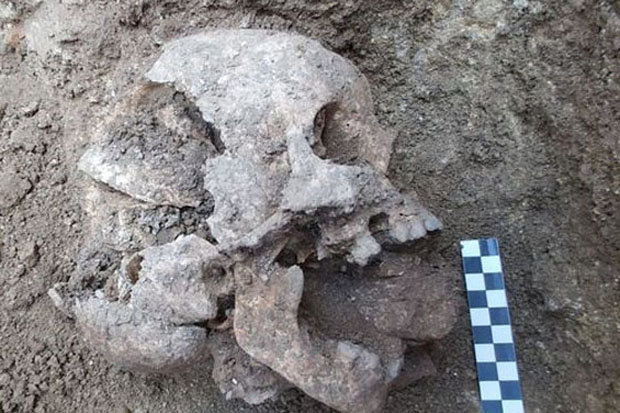IT’s a macabre site: an ancient Roman graveyard dedicated to children — most of them aged less than three. One of them, however, was very different.
University of Arizona, Stanford University and Italian archaeologists have uncovered a skeleton dating from the end of the Roman empire and the start of the Dark Ages. It belonged to a 10-year-old. And extraordinary measures had been taken to prevent the child from rising from the dead.
Forced into its mouth was a large rock.
“I’ve never seen anything like it. It’s extremely eerie and weird,” says archaeologist Professor David Soren. “Locally, they’re calling it the ‘Vampire of Lugnano’.”
It’s a ritual similar to other burials found throughout Europe where skeletons have been found with stakes or stones forced down their throats.
Experts believe it is part of a ritual based on the beliefs of the time — that disease was the mark of demonic infestation. The ‘vampire’ burial practice was supposed to stop the disease from being spread by the undead.
It’s not the first sign of superstition-based rituals found at the Necropoli dei Bambini — Cemetery of the Babies — which dates from the mid-fifth century.
It was a futile attempt at disease control.
“We know that the Romans were very much concerned with this and would even go to the extent of employing witchcraft to keep the evil — whatever is contaminating the body — from coming out,” Soren says.
Among the infant and toddler bones have been found raven talons, toad bones, bronze cauldrons filled with ash — and sacrificed puppies.
Researchers excavating the commune of Lugnano in Teverina in the Italian region of Umbria believe the child may have been suffering malaria.
Not that the locals had any idea what that was, at the time.
Nevertheless, according to DNA analysis of the remains, an outbreak appears to have swept through the region — killing many babies and young children.
They were buried among the ruins of a 1st Century Roman villa.
“Given the age of this child and its unique deposition, with the stone placed within his or her mouth, it represents, at the moment, an anomaly within an already abnormal cemetery,” Excavation director David Pickel says. “This just further highlights how unique the infant — or now, rather, child — cemetery at Lugnano is.”
Excavations at the site since 1987 had previously uncovered the remains of 50 children, the oldest of which had previously been a three-year-old girl.
That girl had been buried with heavy stones placed over her hands and feet. Archaeologists say this was also an attempt to make sure the dead girl stayed in her grave.
Similar burials where large stones have been placed in the mouth have been found across Europe, including in Venice. Here an elderly 16th-century woman, dubbed the ‘Vampire of Venice’ was found with a brick in her mouth in 2009. In Northamptonshire, England, an adult male from the third or fourth century was found buried facedown with his tongue removed and replaced with a stone.
“This is a very unusual mortuary treatment that you see in various forms in different cultures, especially in the Roman world, that could indicate there was a fear that this person might come back from the dead and try to spread disease to the living,” Wilson said.
“It’s a very human thing to have complicated feelings about the dead and wonder if that’s really the end.
“Anytime you can look at burials, they’re significant because they provide a window into ancient minds. We have a saying in bioarchaeology: ‘The dead don’t bury themselves.’ We can tell a lot about people’s beliefs and hopes and by the way they treat the dead.”
https://www.youtube.com/watch?v=j5C51SUgRPo








